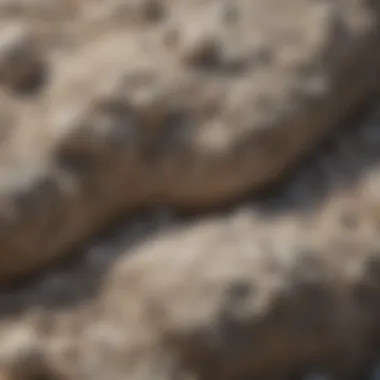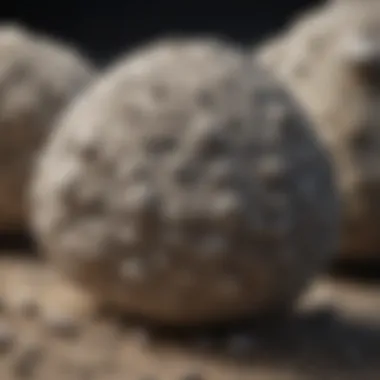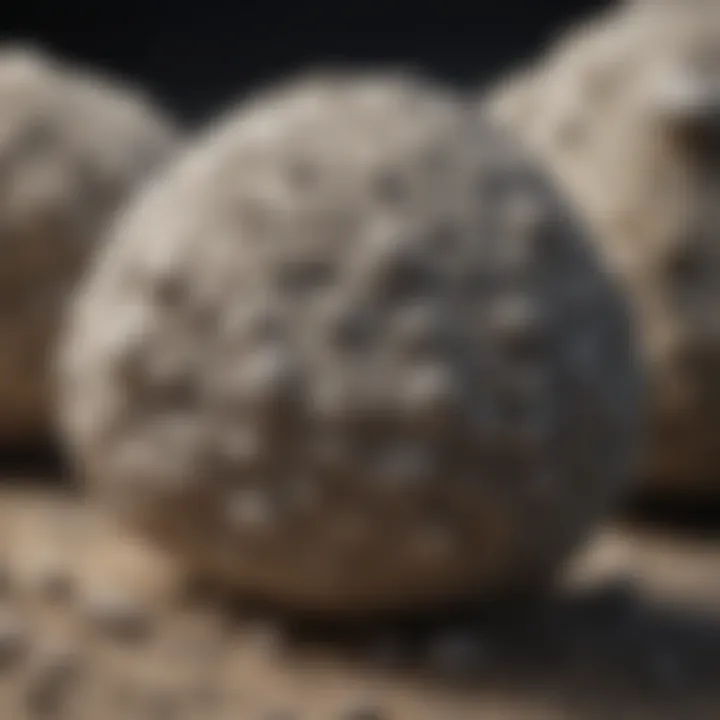Exploring Pumice Rock: Properties and Applications


Intro
Pumice rock stands out in the family of volcanic materials, often overshadowed by more formidable stones like basalt or granite. However, this light, porous rock is not just an afterthought of geological processes. It has a distinct character all its own, formed by the sudden cooling and depressurization of lava that traps gas bubbles, resulting in its unique texture. Understanding pumice involves peeling back the layers of its formation, properties, and its versatile applications that cut across various industries.
Many rock enthusiasts and professionals alike have become captivated by pumice, appreciating not only its aesthetic appeal but also its practical uses. From myriads of applications in constructing materials to niche areas in creative crafts, pumice rocks have a broader significance than one might initially presume.
This article will guide you through the compelling aspects of pumice, exploring how it forms, what it looks like, and where its true value lies across different domains. Whether you are a collector, an environmentalist, or simply a curious reader, this exploration aims to enhance your understanding of pumice and its role on our planet.
Prologue to Pumice Rock
Pumice rock is a subject that's surprisingly essential in various fields. This volcanic glass, formed from lava enriched with gases, has more than just geological importance. In this introduction, we will take a closer look at what pumice is and why it matters not just to geologists but also to collectors and various industries. Pumice isn't your everyday rock; it serves many purposes, from construction materials to skincare products. In short, understanding pumice helps us appreciate its diverse role in our environment and economy.
Defining Pumice Rock
Pumice can be defined as a light, porous volcanic rock. When lava erupts, it often contains gases that create bubbles. As the lava cools rapidly, these bubbles get trapped, leading to a frothy texture. This texture is what distinguishes pumice from other types of volcanic rock. It's often grayish-white to light beige and can vary in size from fine-grained particles to larger chunks. One can find pumice in many regions around the globe, particularly in areas with a history of volcanic activity.
Importance in Geology
In the eyes of geologists, pumice reveals much about volcanic eruptions and the geological processes underlying the Earth’s crust. It’s like a natural record of explosive volcanic activity. When scientists study pumice, they can glean information about gas contents during eruptions. This exploration helps in understanding volcanic behavior, contributing to better predictive models of eruptions. Furthermore, pumice contributes to soil formation and affects erosion patterns. It serves as a fantastic medium for growing plants due to its lightweight and porous nature, highlighting its importance beyond geological studies.
Pumice is not merely a rock; it is a window into the dynamic processes that shape our planet.
In summary, by defining what pumice rock is and highlighting its geological significance, we set the foundation for understanding its numerous applications. Whether you’re a collector or a professional, recognizing the value of pumice is crucial as we journey deeper into its properties and uses.
Formation Processes
Understanding how pumice rock forms is crucial for anyone intrigued by geology, earth sciences, or the natural world at large. The formation processes of pumice rock not only reveal the dynamic forces at play during volcanic eruptions but also highlight the role of gas expansion and cooling in shaping this unique material. Such knowledge can benefit collectors by guiding their search for pumice, while providing insights into its global significance in various industries.
Volcanic Eruptions and Gas Expansion
Pumice rock primarily originates from explosive volcanic eruptions, a spectacle that can be both beautiful and deadly. During these eruptions, magma from deep within the Earth rushes to the surface. The pressure drop as the magma ascends allows dissolved gases, usually water vapor along with other elements, to escape. This rapid release of gas—think of it like opening a shaken soda bottle—creates a bubbly foam of lava that expands dramatically.
The frothy lava cools quickly and solidifies, forming pumice. Its unique property of being lightweight and porous comes directly from this gas expansion. Each bubble within the rock is a remnant of those trapped gases. This is why pumice can float on water— it’s truly a testament to the power of nature.
The environmental conditions during the eruption also play a role. Varieties of pumice can be distinguished based on the intensity of the eruption and the composition of the magma. For instance, eruptions that release more gas tend to produce more porous pumice, while less explosive eruptions yield denser varieties. In different geographic regions, you can find striking discrepancies in color and texture, each telling a story of its explosive origin.
"Pumice, the rock born of fire, reflects the complexity of geological processes and serves as a window into Earth’s violent past."
Cooling and Solidification
Once the turbulent eruption subsides, what follows is the cooling and solidification stage that contributes to the rock's final characteristics. The temperature and the atmosphere in which the pumice solidifies determine its physical attributes. Rapid cooling—often occurring once the pumice reaches higher altitudes and encounters lower temperatures—allows the gas bubbles to remain trapped in the solid material.
As this foamy mass cools, it crystallizes into a solid structure. This solidification gives pumice its light weight, which is markedly different from other types of volcanic rock like basalt, which is dense and heavy. Pumice is typically formed in layers, each indicating different phases of volcanic activity. Collectors might notice how the pumice's texture can vary; some pieces will feel rough due to larger air pockets, while others might be smoother, reflecting a different cooling history.
Both the gas expansion and solidification processes are vital to understanding why pumice serves various functions. From insulation materials in construction to soil additives for farming, the properties derived from these formation processes highlight its versatility.
In summary, grasping the formation of pumice rock through volcanic eruptions and the subsequent cooling provides a deeper appreciation for its place within both nature and industry. Knowing where and how to find pumice can enhance the enjoyment and understanding for collectors and professionals alike.
Physical Properties of Pumice
The physical properties of pumice are fundamental in understanding not only its geological formation but also its various applications across numerous industries. These characteristics make pumice a versatile material that serves different purposes, from construction to cosmetic uses. By examining its lightweight and porous structure as well as its color variations and texture, we can appreciate why this volcanic rock has captured the interest of many collectors and professionals alike.
Lightweight and Porous Structure
Pumice rock is renowned for its lightweight composition. This feature stems from the high gas content that gets trapped during its formation from volcanic eruptions. As the lava cools, the gas forms numerous bubbles, which when solidified, give pumice its distinctive lightweight properties. This characteristic allows pumice to float on water, which is quite a sight!
Such a porous structure is not just a quirk; it translates into practical benefits. For instance, in construction, pumice aggregate is used in lightweight concrete and insulation. Homes built with pumice blocks tend to exhibit lower energy costs because of their superior insulating properties. Additionally, in horticulture, it's valued for improving soil aeration and drainage, making it essential for greener thumbs everywhere.
Color Variations and Texture


When it comes to color and texture, pumice is a true chameleon. The specific minerals present during its formation can create a stunning palette of colors ranging from gray, beige, to even brown or pink. This variation allows pumice to be embraced not only in industrial applications but also in artistic endeavors. Artists use colored pumice as a natural pigment in various forms of artwork, injecting organic beauty into their creations.
The texture of pumice is as unique as its color. The rough surface—filled with small holes and cavities—provides an abrasive quality. This is why pumice stones are widely utilized in cosmetic products. They serve as excellent exfoliants, which gently slough off dead skin. One could say that pumice is a rock with a dual personality—set in the rugged landscape, yet a gentle companion in self-care.
"Pumice is more than just a rock; it's a testament to the dynamic processes of our planet and the myriad ways we utilize nature’s offerings."
To sum up, the physical properties of pumice—its lightness, porosity, and colorful variations—not only provide immense practical benefits but also tie into our appreciation of natural beauty and resourcefulness. Understanding these aspects deepens the respect we hold for this volcanic asset and fuels the curiosity of collectors and enthusiasts who seek to explore its potential.
Chemical Composition
Understanding the chemical composition of pumice rock is crucial in recognizing not just its physical attributes but also its functional versatility. The makeup of pumice contributes to the lightweight property that makes it sought after in various industries, from construction to gardening. Pumice contains a cocktail of minerals that define its performance and responsiveness to different applications.
Major Element Content
Pumice rock predominantly comprises silica, aluminum oxide, and iron oxide, among other components. Silica, often in the form of silicon dioxide, can constitute anywhere from 50% to 80% of pumice's weight. This high silica content contributes significantly to its strength and its ability to withstand varied weathering conditions.
Aluminum oxide is another substantial presence, providing durability in construction-related uses. It does well when mixed with Portland cement, enhancing the material's overall properties.
- Silica: 50-80% of pumice weight
- Aluminum Oxide: Strengthening component
- Iron Oxide: Offers color variations and slight weight adjustments
The balance of the rock can include other elements such as magnesium and calcium, which can vary based on the specific volcanic source from which the pumice is derived. Understanding these elements allows collectors to estimate both the composition and value of the pumice they acquire.
Impurities and Trace Elements
Pumice rocks are usually not pure, and this is where impurities and trace elements come into play. These can include minerals like mica or zeolites, often found in volcanic deposits. While impurities may seem like a hindrance, they can sometimes enhance the usability of pumice in unique ways.
Trace elements, while present in minimal amounts, can affect the overall characteristics of the pumice. For example, the presence of iron can contribute to a darker hue, which might be aesthetically desirable for decorative purposes.
Conversely, impurities can negatively impact some uses, particularly if they interfere with the material's durability or weight. Therefore, analyzing pumice for these trace elements is an essential practice among collectors.
"The chemistry behind pumice reveals not just its age through geological history but also its potential through industrial applications."
In summary, the chemical composition of pumice rock isn't merely a scientific curiosity; it's a vital aspect that dictates how this unique rock can be utilized across various industries and applications. The presence of major elements and trace contaminants forms the backbone of its utility and significance in both natural and commercial realms.
Uses of Pumice Rock
Pumice rock is not just an interesting geological phenomenon; it serves a variety of practical purposes in fields ranging from construction to cosmetics. The versatility of pumice stems from its unique physical and chemical properties, which influences its applications across different sectors. This section aims to explore these uses in-depth, shedding light on why pumice is a valuable resource.
Industrial Applications
Construction Materials
Pumice's lightweight yet robust nature makes it a staple in construction materials. This quality allows for reduced weight in concrete mixtures, leading to easier handling and transportation. In many ways, it acts like a sponge, taking in lighter aggregate materials, which helps to decrease the overall mass of various structures, making it an essential asset for builders and architects. Pumice-styrofoam composites are gaining traction in building applications due to their insulating properties and resistance to fire, making it a popular choice among eco-friendly builders. With increasing demands for sustainable materials, pumice fits the bill nicely as it is sourced through natural processes.
However, it's not all sunshine and rainbows. While it is a fantastic insulator, its brittleness means care must be taken during handling, as it can easily break if not treated with sufficient caution.
Abrasives and Cleaners
When it comes to abrasives, pumice rock really shines. One notable application is in various cleaners and abrasive products. Pumice powder is commonly found in formulations designed for scrubbing surfaces, thanks to its granular yet gentle texture that effectively lifts dirt and grime without scratching delicate surfaces. This makes it a favorable option in the household and industrial cleaning markets.
Unique in its application, pumice functions as an eco-friendly alternative to synthetic materials, which is appealing for consumers looking for sustainable options. However, it’s worth noting that its effectiveness has limitations on softer materials; it could potentially leave scratches if used on surfaces that are not robust.
Agricultural Benefits
Improving Soil Aeration
In agriculture, pumice serves as a natural amendment to soil, enhancing aeration. By mixing it into the earth, plants can develop deeper root systems, promoting healthier growth. This property is particularly significant in compacted soils where traditional aeration techniques might fall short. Its lightweight nature ensures that it doesn’t weigh down the soil structure, allowing roots to spread more freely.
Interestingly, pumice can also bring grains of nutrients to the table, acting as a slow-release source for essential elements. This makes it a valuable addition for organic and sustainable farming practices, which prioritize healthy soil over synthetic fertilizers. But it's not without concerns; over-application could lead to overly porous soils, causing bought nutrients to leach away faster than intended.
Enhancing Water Retention


Water retention is a persistent issue in many agricultural practices. Pumice showcases an ability to absorb water much like a sponge. When mixed with soil, it improves moisture retention, making it an invaluable resource in drier climates. While some amendments might crumble under drought stress, pumice remains resilient and effective, promoting a suitable environment for crops.
On the downside, if used excessively, it can lead to overly saturated soils, resulting in root rot and other moisture-related ailments for plants. Monitor application rates closely to find that sweet spot where crops thrive.
Cosmetic Uses
Exfoliating Scrubs
In the beauty sector, pumice has carved a niche for itself as an exfoliating agent. Used in scrubs, it helps to buff away dead skin, revealing the soft skin beneath. Its porous structure aids in gentle exfoliation, a key characteristic that rightly places it among the preferred natural ingredients in skincare products. Its ability to remove grime and buildup makes it a beneficial substance in spa treatments.
However, it’s crucial to ensure that the particles are finely milled. Coarse pumice can lead to micro-tears on the skin if used aggressively. Proper formulation ensures a safe, effective scrub that leaves skin feeling rejuvenated.
Foot Care Products
Foot care has also benefited from the properties of pumice. Products designed for foot therapy include pumice stones that help in removing hard skin and calluses. The unique characteristic of pumice here is its effective balance between gentleness and abrasiveness, making it a valuable tool in personal care routines. Its natural origin adds an appealing touch for consumers seeking organic beauty solutions.
Nevertheless, caution is necessary. Overuse can lead to skin irritation, and users should vary their applications to avoid adverse effects. The key is to use it as part of a broader foot care regimen that incorporates hydration and soothing agents to maintain overall foot health.
The diverse applications of pumice rock highlight its significance beyond its geological allure, appealing to a wide spectrum of industries and individuals alike.
Pumice in the Natural Environment
Pumice rock plays a crucial role in shaping the natural environment. Its unique properties do not just dictate its physical presence but also how it influences the surrounding ecosystems. Understanding pumice’s implications leads to greater insights into both ecological balance and geological processes.
Habitat for Flora and Fauna
The lightweight and porous nature of pumice creates a favorable habitat for various forms of life. When pumice deposits accumulate, they often form unique microhabitats, especially in volcanic regions where soil may be scarce. Nestled within the tiny cracks and crevices, organisms such as lichen, moss, and certain fungi find refuge. These species not only thrive on pumice but also help in soil formation and stabilization, paving the way for larger plants.
Notably, certain insect species also take advantage of pumice's structure, using it for shelter or a breeding ground. For example, some ants create nests in the hollows of pumice, which allows them to regulate temperature and humidity, enhancing their chances of survival.
"Pumice acts like nature's sponge, soaking up moisture and creating life-supporting pockets in otherwise harsh environments."
Role in Erosion and Sedimentation
Pumice's role in erosion and sedimentation is equally significant. Its lightweight property means that it can be easily transported by wind and water, redistributing nutrients across landscapes as it moves. This mobility aids in the formation of soil, which is vital for plant growth.
Moreover, when pumice breaks down, it releases minerals that enhance soil fertility. This is particularly true in regions where volcanic activity has created pumice-rich soils, contributing to lush vegetation despite adverse conditions.
Erosion control is another key factor. Pumice can help stabilize slopes by reducing runoff and preventing excessive soil loss during heavy rains. Those who work in land management often utilize pumice for this very reason, promoting biodiversity in various landscapes.
In summary, pumice rock does much more than simply exist as a geological wonder; it fosters life, supports ecosystems, and plays an essential role in maintaining environmental stability. Its contributions are critical to understanding both local and broader ecological contexts.
Pumice Rock and Culture
Pumice rock's role in various cultural contexts is more significant than one might expect. While often overshadowed by its industrial uses, it carries a rich heritage that intertwines with both ancient and modern practices. Understanding this cultural facet can enhance the appreciation of pumice beyond its physical attributes.
Historical Significance
Pumice rock has been utilized for centuries, tracing back to ancient civilizations. The Romans, for instance, prized pumice for its lightweight nature and exceptional abrasiveness. They used it in construction and even as a beauty aid, demonstrating early recognition of its various qualities. The historical use of pumice in architecture is noteworthy; it helped create structures that are still standing today, like the Pantheon, which showcases impressive techniques that incorporated pumice concrete into its design.
In cultures around the Mediterranean, pumice was essential for economic and social developments. For instance, during the Byzantine Empire, it was utilized in building materials, signifying both practicality and status. Its abundant availability in volcanic regions made it a resource that was both valued and widely used.
Moreover, the historical lens offers insight into how societies interacted with their natural environment. This usage of pumice can be seen as a symbol of human adaptability, showcasing how civilizations transformed raw material into tools, beauty products, and architectural advancements.
Artistic Uses Throughout History
Artistic expressions using pumice are as diverse as they are enchanting. Throughout different epochs, artists have harnessed the properties of pumice to create striking sculptures and paintings. By grinding pumice into powder, artists achieved unique textures in their work, allowing them to manipulate both light and shadow in ways that enhance aesthetic appeal.
In the realm of sculpture, Italian artists during the Renaissance tapped into pumice’s lightweight possibilities, creating intricate forms that were both profound and awe-inspiring. It enabled these creators to push the boundaries of traditional stone carving, resulting in works that captured the human spirit.
Pumice has also found its way into modern art. Contemporary painters sometimes incorporate pumice into their mediums, utilizing it for its textural quality to create multidimensional effects on canvas. This technique showcases the ongoing relevance of pumice in artistic realms, reflecting a continued fascination with natural materials.


"Pumice rock transcends its mere geological definition, embodying history, culture, and artistic expression in its porous forms."
Collecting Pumice Rock
Collecting pumice rock offers a rich tapestry of experience for enthusiasts and hobbyists alike. It’s not just about gathering interesting stones; it’s about connecting with nature and appreciating the geological processes that create these unique materials. Pumice, with its lightweight and porous characteristics, has drawn attention from collectors around the globe. For those who relish in the beauty of rocks and minerals, understanding where to find pumice and how to effectively collect it is paramount.
Where to Find Pumice
Pumice can be found in various places, primarily in regions with volcanic activity. Here are some notable locations that serve as treasure troves for collectors:
- Iceland: Known as a volcanic paradise, this country is home to many natural deposits of pumice. The ash and lava fields scattered throughout provide excellent opportunities for collection.
- Italy: Areas like Mount Etna not only offer breathtaking views but also feature pumice in its natural setting. An excursion to such sites can be both educational and rewarding.
- United States: The state of California, particularly around the Mono Basin, is famous for its pumice deposits. The light, airy stones found here make excellent specimens for any collection.
While these locations are a great starting point, stop by local volcanic sites or inquire at geological parks. Keep an eye out for public lands where collecting is permitted, as some regions may have specific regulations that collectors need to follow.
Tips for Collectors
Collecting pumice rock can turn into an enriching experience with the right preparation and approach. Here are some practical tips to enhance your collecting endeavors:
- Research: Before heading out, do a bit of reading on the geological features of the area. Knowing the characteristics of pumice—such as its color and texture—can help in identifying quality specimens.
- Get the Right Gear: Equip yourself with durable gloves and a sturdy bag for collection. Since pumice tends to be light, it's easy to carry, but having a reliable container will keep your finds safe.
- Respect Local Guidelines: Always check for regulations regarding collection. Some areas may have restrictions to protect the environment and geological integrity. Adhere to Leave No Trace principles to minimize impact.
- Join a Community: Engaging with other collectors online or in local groups can provide insight and tips. Websites like reddit.com often host forums where enthusiasts exchange experiences and advice.
- Record Your Finds: Keep track of where and when you collected each piece. This documentation adds value to your collection and helps in understanding regional variations.
"The journey of collecting is as rewarding as the finds themselves; each specimen tells a story about the earth and its history."
By following these simple yet effective tips, collectors can deepen their understanding and appreciation of pumice while ensuring that their collecting practices are sustainable and responsible.
Considerations for Sustainable Use
Sustainable usage of pumice rock is becoming increasingly vital as the demand for this unique volcanic material rises across several industries. While its properties make pumice rock attractive for various applications, it is essential to recognize the potential consequences of excessive mining and collection practices. Bringing awareness to these factors ensures this natural resource remains available for future generations while minimizing adverse effects on the environment.
Environmental Impact of Pumice Mining
When it comes to extracting pumice, the environmental footprint can be significant. The process of pumice mining, often involving large-scale operations, can disturb local ecosystems. Areas where pumice is mined may suffer from soil erosion, habitat destruction, and alterations to water flows. As large sections of land are excavated, the natural breeding grounds for wildlife may vanish, leading to shifts in local biodiversity.
A greater awareness of these impacts has sparked discussions about the sustainability of extraction practices. Here are some key considerations:
- Ecosystem Disruption: The environmental balance is affected, often leading to a decline in plant and animal species.
- Soil Erosion: With root systems uprooted, soil is left vulnerable to erosion, posing long-term risks to land quality.
- Water Contamination: Mining operations may inadvertently introduce pollutants into water systems, jeopardizing local flora and fauna.
Minimizing these impacts calls for stricter regulations and mindful practices to ensure pumice extraction does not significantly harm the environment.
Best Practices for Collection and Use
For rock and fossil collectors, adhering to sustainable practices while collecting pumice is paramount. Here are a few guidelines that can be followed to mitigate the impact on the environment:
- Responsible Sourcing: Always buy pumice from sources that practice sustainable mining. Check if they adhere to environmental regulations to ensure responsible extraction.
- Limit Collection: When collecting pumice, abide by local laws and guidelines. Taking only what you need reduces pressure on natural resources.
- Support Restoration Efforts: Engage with organizations that work towards restoring mining sites and maintaining local ecosystems. Your involvement can make a difference.
"The careful balance between utilizing natural resources and preserving our environment is not just a necessity but a responsibility we all share."
The End
Pumice rock holds a unique position in both the natural world and various human applications. Its lightweight, porous structure makes it not only fascinating from a geological standpoint but also incredibly versatile across industries. This article has taken you through the formation processes of pumice, from volcanic eruptions to the cooling and solidification that follow. Understanding these processes is crucial, as it gives collectors and enthusiasts a backdrop to the natural history embedded in each fragment of pumice they encounter.
Recapitulation of Pumice Rock's Importance
Pumice's importance can be summed up in its multifaceted uses. In construction, its lightweight nature allows it to serve as an excellent aggregate in concrete, providing strength without adding significant weight. Its abrasiveness has made it invaluable in many cleaning products, such as those used to smooth out rough surfaces and skin. In agriculture, pumice improves soil aeration and water retention, crucial elements for many farming practices. Its historical significance and cultural relevance add layers to its value, as many artists have found creative inspiration in its rugged form.
Moreover, for people involved in rock and fossil collecting, pumice presents a gateway to understanding volcanic activity and its consequences on our planet. Collecting these rocks not only satisfies the curiosity but also contributes to the appreciation of geological forms.
Future Outlook and Research Opportunities
Looking forward, the future of pumice research holds several exciting avenues. There are ongoing studies exploring its potential in environmental sustainability. For instance, researchers are evaluating its uses in carbon capture technology. Pumice could potentially help sequester carbon dioxide from the atmosphere due to its porous structure.
Additionally, advances in material science offer possibilities for new applications in various products, from eco-friendly construction materials to innovative landscaping solutions. The demand for sustainable resources is on the rise, and treating pumice as a valuable renewable material could lead to breakthroughs in how we perceive and utilize natural resources.
Rock collectors should keep an eye on emerging research; this insight can enhance not just personal collections, but also contribute to informed discussions around the topic of pumice. More hands-on field studies would deepen our understanding and appreciation of this volcanic wonder.
"Pumice is more than just a rock; it’s a story of fire, water, and air, all woven together in a tapestry of geological history."
As we draw this discussion to a close, it’s clear that pumice will continue to intrigue, inspire, and serve future generations, making it a highlight for both collectors and researchers.



